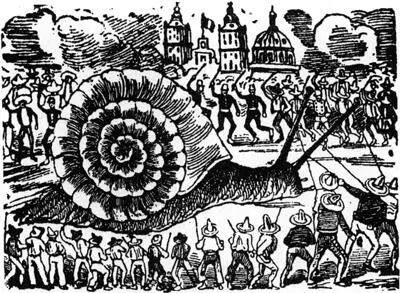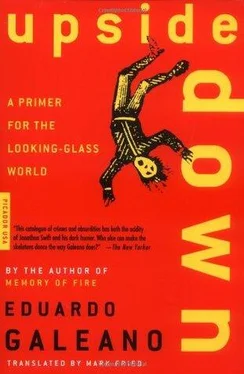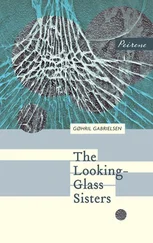In the name of freedom — free enterprise, freeways, and the freedom to buy — the world’s air is becoming unbreathable. Cars aren’t the only guilty party in this daily act of murder, but they’re the worst culprits. In cities the world over, they produce most of the noxious cocktail that destroys our lungs and eyes and everything else. They cause most of the noise and tension that makes our ears hurt and our hair stand on end. In the North, cars are generally obliged to use fuels and technologies that at least limit the poisons they give off — a big improvement, if only cars didn’t reproduce like flies. But in the South, it’s much worse. Only rarely are unleaded gas and catalytic converters required, and even then the law is respected but not obeyed, as tradition dating from colonial times would have it. Ferocious volleys of lead penetrate the blood with utter disdain, attacking the lungs, liver, bones, and soul.
The inhabitants of Latin America’s largest cities spend their days praying for rain to cleanse the air or wind to carry the poison elsewhere. Mexico City, the largest city in the world, lives in a state of perpetual environmental emergency. Five centuries ago, an Aztec song asked:
Who could lay siege to Tenochtitlán?
Who could move the foundations of the heavens?
Today the city once called Tenochtitlán is under siege from pollution. Babies are born with lead in their blood and one person in three suffers frequent headaches. The government’s guidelines for dealing with the motorized plague read like a defense against an invasion from Mars. In 1995, the Metropolitan Commission for the Prevention and Control of Environmental Pollution advised residents of Mexico’s capital that on so-called days of environmental contingency, they should go out of doors as little as possible, keep doors, windows, and vents closed, not exercise between 10 a.m. and 4 p.m.
On those days, which occur ever more frequently, more than half a million people require some sort of medical attention from breathing what was known not so long ago as “the most transparent of air.” At the end of 1996, fifteen poor peasants from the state of Guerrero marched in Mexico City to protest injustices; all of them ended up in the public hospital.

On another day that year, it rained oceans on the city of São Paulo, creating the largest traffic jam in the country’s history. Mayor Paulo Maluf celebrated: “Traffic jams are a sign of progress.”

A thousand new cars take to the streets of São Paulo every day. The city breathes on Sunday and chokes the rest of the week. Only on Sunday can you see the skyline from the outskirts. The mayor of Rio de Janeiro, Luiz Paulo Conde, also likes traffic jams. Thanks to that blessing of urban civilization, he once said, motorists can talk on their cell phones, watch their portable TVs, and enjoy music on their cassettes or compact discs. “In the future,” the mayor announced, “a city without traffic jams will be considered boring.”
His prediction coincided with an ecological catastrophe in Santiago de Chile. Schools were closed and crowds of children packed the emergency rooms. In Santiago, environmentalists say, each child breathes the equivalent of seven cigarettes a day and one child out of four suffers some form of bronchitis. The city is separated from the heavens by an umbrella of pollution that has doubled in density over the past fifteen years, a period when the number of cars has also doubled.
The “airs” of the city called Buenos Aires grow more poisonous year by year, keeping pace with the vehicles, which increase by half a million every twelve months. In 1996, sixteen neighborhoods already suffered “very dangerous” noise levels, a perpetual racket that the World Health Organization says “can produce irreversible damage to human health.” Charlie Chaplin liked to say that silence is the gold of the poor. Years have passed and silence is ever more the privilege of the few who can afford it.
It’s a Joke/1
On a large avenue in a large Latin American city, a man is waiting to cross. He stands at the curb, trapped by the incessant flow of cars. The pedestrian waits ten minutes, twenty minutes, an hour. Then he turns his head and spies a man leaning against a wall, smoking. And he asks, “Tell me, how do I cross to the other side?”
“I don’t know,” the man responds. “I was born over here.”
Consumer society imposes its own symbolism of power and its own mythology of social progress. Advertising sends out invitations to join the ruling class; all it takes is a magic little ignition key. “Have it your way!” thunders the voice that gives the orders in the market. “You are in charge!” “Strut your stuff!” And if you put a tiger in your tank, according to the billboards I recall from my childhood, you’ll be quicker and stronger than anyone else, crushing whoever blocks your path to success. Language creates a reality that advertising depends on, but real reality isn’t at all like the spells of commercial witchcraft.
For every two children born into the world a car is born, and the automotive birthrate is gaining on the human one. Every child wants to own a car, two cars, a thousand cars. How many adults will be able to realize their childhood fantasies? The numbers show cars to be a privilege, not a right. One-fifth of humanity owns four-fifths of the cars, even though all five-fifths of humanity have to breathe the poisoned air that results. Like so many other symbols of consumer society, cars belong to a minority whose habits are parlayed into universal truths, obliging the rest of us to see cars as the only possible extension of the human body.
It’s No Joke/1
Managua, Las Colinas neighborhood, 1996. It’s a night for celebrating: Cardinal Obando, the U.S. ambassador, several government ministers, and the cream of local society attend the inauguration. They raise their glasses to toast Nicaragua’s prosperity. Music and speeches resound.
“This is how you create jobs,” declares the ambassador. “This is how you build progress.”
“It’s just like being in Miami,” gushes Cardinal Obando. Smiling for the TV cameras, His Eminence cuts the red ribbon on the new Texaco station. The company announces that it will build more service stations in the near future.
The number of cars in Latin America’s Babylons keeps swelling but it’s nothing compared with that in the centers of world prosperity. In 1995, the United States and Canada had more motor vehicles than the rest of the world combined, Europe aside. Germany that year had as many cars, trucks, pickups, mobile homes, and motorcycles as all of Latin America and Africa. Yet it’s in the cities of the South where three out of every four deaths by car occur. And of the three who die, two are pedestrians. Brazil has a third as many cars as Germany but three times as many victims. Every year Colombia suffers six thousand homicides politely called “traffic accidents.”
Advertisements like to promote new cars as if they were weapons. At least that’s one way ads aren’t lying. Accelerating is like firing a gun; it offers the same pleasure and the same power. Every year cars kill as many people as were killed at Hiroshima and Nagasaki. In 1990, they caused many more deaths or disabilities than wars or AIDS. According to World Health Organization projections, in the year 2020 cars will be the third-largest cause of death or disability. Wars will be eighth, AIDS tenth.
Читать дальше













